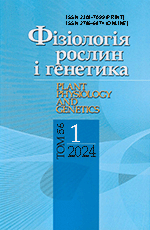Агароза — полісахарид, що міститься в клітинних стінках червоних водоростей. Більшість виявлених агаролітичних мікроорганізмів є грам-негативними бактеріями з кількох таксономічно різноманітних груп, але було виявлено також кілька грам-позитивних, наприклад, Bacillus sp. MK03, Streptomyces coelicolor A3(2). S. coelicolor A3(2) ферментує агарозу за допомогою 3 різних гідролаз: двох позаклітинних b-агараз (DagA і DagB) і внутрішньоклітинної a-неоагаробіозної гідролази ScJC117. Мета роботи полягала в ідентифікуванні штамів стрептоміцетів, геноми яких містять послідовності, подібні до генів, що кодують білки агаролітичної системи S. coelicolor A3(2). Об’єктами дослідження були нуклеотидні послідовності стрептоміцетів, депоновані в базах даних Національного центру біотехнологічної інформації (NCBI, США). Аналіз первинних структур ДНК стрептоміцетів проводили за допомогою програм BLASTN на сервері NCBI. BLASTN-аналіз інформації в базах даних NCBI виявив наявність у них 5 таких штамів (Streptomyces sp. SID7813, Streptomyces sp. NRRL B-16638, Streptomyces sp. ME02-6977A, Streptomyces sp. SM1, Streptomyces sp. S4.7). Їх послідовності містять фрагменти, подібні генам S. coelicolor A3(2), які кодують агаролітичні ферменти та особливу NA2-транспортну систему неоагаробіози. На підставі схожості послідовностей їхніх «генів господарювання» (rpoB, rrnA, gyrB, atpB, trpB, recA) зроблено висновки про близьке споріднення 4 штамів (Streptomyces sp. SID7813, Streptomyces sp. NRRL B-16638, Streptomyces sp. ME02-6977A, Streptomyces sp. SM1) і S. coelicolor A3(2). Штам Streptomyces sp. S4.7 належить до штамів іншого виду (S. niveus).
Ключові слова: Streptomyces sp., агараза, гідроліз, транспортна система, генетична спорідненість
Повний текст та додаткові матеріали
У вільному доступі: PDFЦитована література
1. Fu, X.T. & Kim, S.M. (2010). Agarase: review of major sources, categories, purification method, enzyme characteristics and applications. Mar. Drugs, 8, No. 1, pp. 200-218. https://doi.org/10.3390/md8010200
2. Wang, J., Jiang, X., Mou, H. & Guan, H. (2004). Anti-oxidation of agar oligosaccharides produced by agarase from a marine bacterium. J. Appl. Phycol., 16, No. 333-340. https://doi.org/10.1023/B:JAPH.0000047944.40463.e6
3. Yamaura, I.T., Matsumoto, M., Funatsu, H. & Shigeiri, S.T. (1991). Purification and some properties of agarase from Pseudomonas sp. PT-5. Agric. Biol. Chem., 55, No. 10, 2531-2536. https://doi.org/10.1080/00021369.1991.10871002
4. Zang, W. &. Li, S. (2007) Cloning, characterization and molecular application of a beta-agarase gene from Vibrio sp. strain V134. Appl. Environ. Microbiol., 73, No. 9, pp. 2825-2831. https://doi.org/10.1128/AEM.02872-06
5. ServHn-Gonz«lez, L., Jensen, M.R., White, J. & Bibb, M. (1994). Transcriptional regulation of the four promoters of the agarase gene (dagA) of Streptomyces coelicolor A3(2). Microbiology (Reading), 140, No. 10, pp. 2555-2565. https://doi.org/10.1099/00221287-140-10-2555
6. Buttner, M.J., Fearnley, I.M. & Bibb, M.J. (1987). The agarase gene (dagA) of Streptomyces coelicolor A3(2): nucleotide sequence and transcriptional analysis. Mol. Gen. Genet., 209, No. 1, pp. 101-109. https://doi.org/10.1007/BF00329843
7. Parro, V. & Mellado, R.P. (1993). Heterologous recognition in vivo of promoter sequences from the Streptomyces coelicolor dagA gene. FEMS Microbiol. Let., 106, No. 3, pp. 347-356. https://doi.org/10.1111/j.1574-6968.1993.tb05987.x
8. Temuujin, U., Chi, W-J., Lee, S-U., Chang, U-K. & Hong, S-K. (2011). Overexpression and biochemical characterization of DagA from Streptomyces coelicolor A3(2): an endo-type b-agarase producing neoagarotetraose and neoagarohexaose. Appl. Microbiol. Biotechnol., 92, No. 4, pp. 749-759. https://doi.org/10.1007/s00253-011-3347-7
9. Suzuki, H., Sawai, Y., Suzuki, T. & Kawai, K. (2002). Purification and characterization of an extracellular alpha-neoagarooligosaccharide hydrolase from Bacillus sp. MK03. J. Biosci. Bioeng., 93, No. 5, pp. 456-463. https://doi.org/10.1016/S1389-1723(02)80092-5
10. Grubbs K.J., Bleich, R.M. & Santa Maria, K.C. (2017). Large-scale bioinformatics analysis of Bacillus genomes uncovers conserved roles of natural products in bacterial physiology. mSystems, 2, No. 6, e00040-17. https://doi.org/10.1128/mSystems.00040-17
11. Chi, W.J., Chang, Y.K. & Hong, S.K. (2012). Agar degradation by microorganisms and agar-degrading enzymes. Appl. Microbiol. Biotechnol., 94, No. 4, pp. 917-930. https://doi.org/10.1007/s00253-012-4023-2
12. Jiang, C., Liu, Z., Cheng, D. & Mao, X. (2020). Agarose degradation for utilization: Enzymes, pathways, metabolic engineering methods and products. Biotechnol. Adv., 45, 107641. https://doi.org/10.1016/j.biotechadv.2020.107641
13. Stanier, R.Y. (1942). Agar decomposing strains of the Actinomyces coelicolor species group. J. Bacteriol., 44. No. 5, pp. 555-570. https://doi.org/10.1128/jb.44.5.555-570.1942
14. Erikson, D. (1948). Differentiation of the vegetative and sporogenous phases of the actinomycetes. 3. Variation in the Actinomyces coelicolor species-group. J. Gen. Microbiol., 2, No. 3, pp. 252-259. https://doi.org/10.1099/00221287-3-3-361
15. Vandamme, P., Pot, B. &. Gillis, M. (1996) Polyphasic taxonomy, a consensus approach to bacterial systematics. Microbiol. Rev., 60, No. 2, pp., 407-438. https://doi.org/10.1128/mr.60.2.407-438.1996
16. Stackebrandt, E., Frederiksen, W., Garrity, G.M., Grimont, P.A.D., K¬mpfer, P., Maiden, M.C.J., Nesme, X., RossellЩ-Mora, R., Swings, J., Trтpe, H.G., Vauterin, L., Ward, A.C. & Whitman, W.B. (2002). Report of the Ad Hoc Committee for the reevaluation of the species definition in bacteriology. Int. J. System. Evol. Microbiol., 52, No. 3, pp. 1043-1047. https://doi.org/10.1099/00207713-52-3-1043
17. Goodfellow, M., Kumar, Y., Labeda, D.P. & Sembiring, L. (2007). The Streptomyces violaceusniger clade: a home for streptomycetes with rugose ornamented spores. Antonie Van Leeuwenhoek, 92, No. 2. pp. 173-199. https://doi.org/10.1007/s10482-007-9146-6
